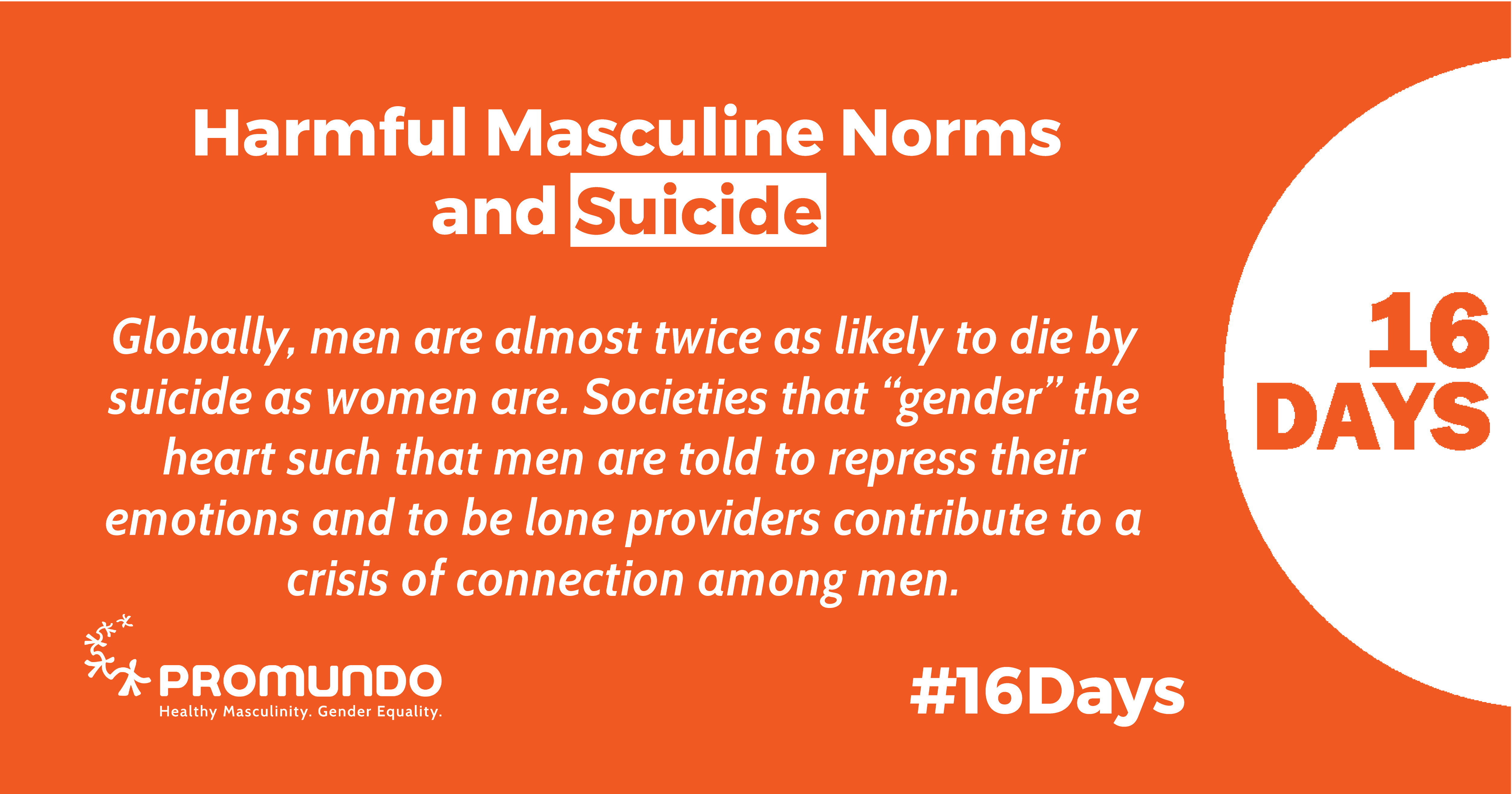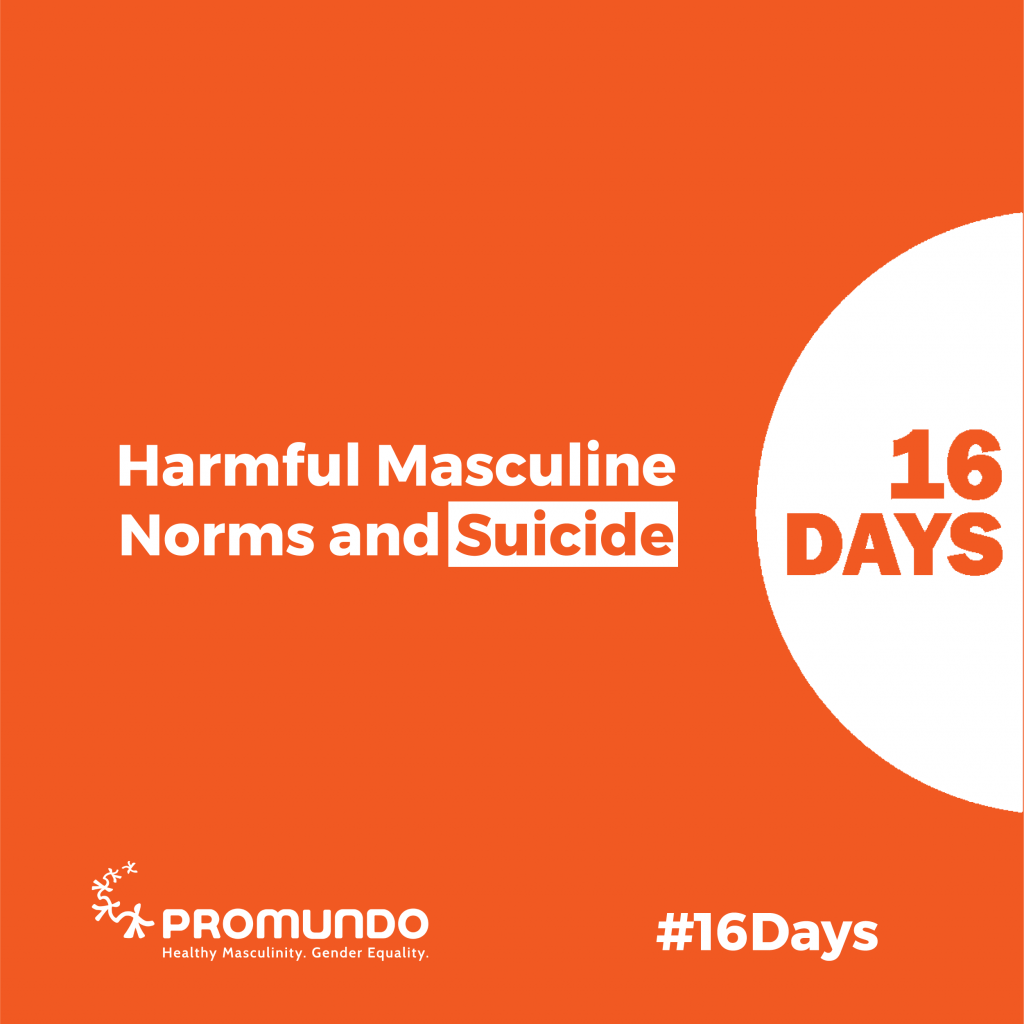Os 16 Dias de Ativismo Contra a Violência de Gênero são uma campanha internacional usada por ativistas ao redor do mundo (25 de novembro a 10 de dezembro) como uma estratégia de organização para pedir a eliminação de todas as formas de violência de gênero.
Este ano, compartilharemos pesquisas sobre as ligações entre normas masculinas prejudiciais e oito formas diferentes de comportamento violento, bem como insights e recomendações para eliminar todas as formas de violência.

Embora não haja nada inerente ao fato de ser homem que impulsione a violência, a maneira como socializamos os meninos em suas identidades como homens e o que esperamos deles — isto é, as normas masculinas da sociedade — estão inegavelmente ligados à violência.
De fato, meninos e homens são frequentemente criados, socializados e incentivados a usar a violência de alguma forma; em geral, homens e meninos têm uma probabilidade desproporcional de perpetrar a maioria das formas de violência e de morrer por homicídio e suicídio. No entanto, a pesquisa afirma que essa violência é prevenível, a igualdade de gênero é alcançável e normas e ideias não violentas sobre masculinidade são predominantes e poderosas.
Relatório da Equimundo e da Oak Foundation Normas Masculinas e Violência: Fazendo as Conexões, examina as ligações entre normas masculinas nocivas e oito formas de comportamento violento. Este sétimo blog no Fazendo as conexões, 16 Dias de Ativismo A série se concentra no suicídio. Ela analisa os fatos sobre o assunto, explora as ligações entre o suicídio e outras formas de violência e fornece recomendações para ação.
Suicídio
Os fatos
A nível mundial, os homens têm quase o dobro da probabilidade de morrer por suicídio do que as mulheres, estimando a Organização Mundial da Saúde (OMS) que Em média, 15 homens por 100.000 e oito mulheres por 100.000 morrem por suicídio, com tremenda variação por país.
Embora o suicídio frequentemente não seja considerado violência, 50% de todas as mortes violentas de homens são suicídios. Enquanto as mulheres são mais propensas a tentar o suicídio, os homens têm maior probabilidade de morrer por suicídio.
Os Links
Normas de gênero prejudiciais podem frequentemente estar na raiz da ideação suicida e do suicídio. Sociedades que "generificam" o coração de tal forma que os homens são instruídos a isolar suas vidas interiores, reprimir suas emoções e ser trabalhadores, protetores e provedores solitários, contribuem para uma crise de conexão entre os homens. Vários estudiosos apontam a alexitimia – a incapacidade de se conectar e comunicar as próprias emoções – como um precursor particularmente masculino da ideação suicida.
O fracasso em cumprir o papel socialmente prescrito de provedor financeiro pode levar alguns homens à automutilação e ao suicídio. Quando os homens são ensinados a serem autossuficientes e independentes a todo custo, eles podem se tornar avessos a buscar serviços de saúde mental, e essa aversão também está associada ao comportamento suicida.
O ato de suicídio também pode ser construído como uma ação masculina ou masculinizada, o que pode explicar por que os homens são mais propensos a usar meios imediatamente fatais, como armas de fogo, ao tentar suicídio.
Todas essas ligações conceituais são ainda corroboradas por dados empíricos que relacionam uma maior adesão a normas masculinas nocivas – seja por homens individualmente, seja conforme expressas na cultura dominante – com o aumento do comportamento suicida entre os homens. A Caixa do Homem estudo, homens jovens nos Estados Unidos, Reino Unido e México que concordaram mais fortemente com normas masculinas prejudiciais — como ser durão, agressivo, controlador e autossuficiente — também foram significativamente mais propensos a relatar ideação suicida nas duas semanas anteriores do que homens jovens que rejeitaram essas normas.
Pesquisas também mostram que normas masculinas prejudiciais ligadas à identidade sexual — particularmente noções heteronormativas e homofóbicas — estão associadas a maiores desafios de saúde mental e risco de suicídio entre indivíduos que se identificam como lésbicas, gays, bissexuais, transgêneros, intersexuais ou de gênero queer.
As Interseções
Pesquisas sobre os fatores de risco para suicídio são limitadas, mas dados sugerem que esses fatores de risco incluem estresse financeiro, problemas de saúde mental, abuso de álcool e problemas de saúde física associados à dor crônica.
Além disso, as diferentes taxas de suicídio entre homens e mulheres ao redor do mundo sugerem que o contexto cultural, os padrões de emprego e a desigualdade de renda, a raça, a etnia e outros fatores demográficos se cruzam com as normas de gênero para influenciar a ideação e os comportamentos suicidas.
A "generificação" do coração e o isolamento emocional cultivado pelos homens muitas vezes significam que eles dificilmente buscam cuidados de saúde formais ou mesmo buscam ajuda e apoio de familiares e amigos quando precisam. No entanto, o acesso a cuidados de saúde adequados, serviços de apoio e apoio social de familiares, amigos e vizinhos é particularmente essencial para conter a ideação e o comportamento suicida dos homens.
Da Teoria à Prática
Há um interesse crescente no uso de abordagens para lidar com normas de gênero prejudiciais no campo da prevenção do suicídio, mas a maioria dessas iniciativas é nova e seu alcance geográfico é limitado. Iniciativas que visam prevenir o suicídio devem se concentrar nas seguintes transformações de normas masculinas prejudiciais:
- Identifique e discuta como as masculinidades normativas “generificam” o coração, suprimem a expressão emocional e podem levar a uma sensação de desconexão, isolamento e angústia.
- Ofereça espaços para homens e meninos expressarem emoções, criarem laços com colegas e construírem um senso de comunidade e pertencimento.
- Envolva os participantes em discussões sobre normas tradicionais de gênero, as pressões para atingir a masculinidade e as expectativas intensas — e muitas vezes irrealistas — colocadas tanto sobre homens quanto sobre meninos.
- Incentivar e legitimar o comportamento de busca de ajuda – incluindo cuidados de saúde mental – entre homens e meninos.
- Explorar e validar formas alternativas não violentas de masculinidade.
